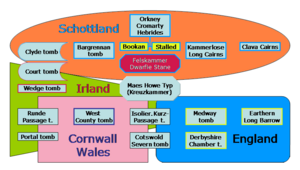British megalith architecture facts for kids
British megalith architecture is the study of the amazing stone structures built by ancient people on the British Isles. These huge stone buildings are called megaliths. Scientists study and record these sites to learn about the people who built them long ago.
The ancient stone sites in Britain are some of the most interesting in all of Europe. Even though they are made of earth, not stone, the long burial mounds in East England are also studied with these stone sites. Special examples of megalithic sites in East England include the Medway tombs and the Derbyshire chamber tombs like Five Wells.
These ancient builders were active in prehistoric times. There are many similar stone structures in Ireland and British areas like Cornwall (including the Isles of Scilly), the Isle of Man, Wales, and Scotland. However, the sites in England and the Channel Islands are a bit different. While most areas have their own special types of megaliths, they also share some designs with nearby regions. For example, the "cruciform passage" tombs of the Maes Howe type in Orkney are also found in Ireland (like Knowth and Newgrange). These types of tombs even stretch down to the Scilly Isles and Devonshire in England. Scotland has many different types of sites, especially on its islands, because of its unique geography.
These ancient monuments show us a lot about the culture and beliefs of the people who lived during the Neolithic Age. How they were built and what they were used for tells us about how societies developed back then.
When Were Megaliths Built?
Scientists have found ways to figure out when these ancient stone structures were used. For example, sites like Street House in North Yorkshire and Hazleton North in Gloucestershire show that people used them for burials for about 200 to 300 years. The small number of burials found at the West Kennet Long Barrow in Wiltshire also suggests this.
However, other clues show that people cared about these monuments for much longer. Pottery found in the ditches of long burial mounds and the dates of old fireplaces near megalithic sites like Monamore on the Isle of Arran suggest that communities kept visiting these places for centuries after the last burial. The building of empty tombs, called cenotaphs, like Tulach an t'Sionnaich in Caithness, also points to this long-lasting interest.
Closing Down Old Sites
In southern England, some burial sites were purposely closed. It's often hard to know exactly when this happened. The main chamber of the West Kennet Long Barrow was used for many centuries but was finally filled in around 2400 B.C. Sometimes, the entrances to these tombs were blocked. This usually meant the tomb was no longer being used for burials. However, finding more than one layer of blocking shows that these decisions were not always final. This makes it tricky to know the exact time a tomb was completely abandoned.
In Scotland, especially up to Shetland, many sites were used and changed over long periods. For example, round mounds sometimes had long burial mounds built over them, like the Grey Cairns of Camster.
New Ideas and Changes
After about 3000 B.C., it's not clear if many new monuments were built in southern England. However, people continued to hold rituals at the older sites. In the northwest, the old traditions probably lasted longer. For example, the change of a classic passage tomb into a henge monument at Bryn Celli Ddu on Anglesey shows that people still focused on these traditional places, even as new types of sites were being built.
The arrival of the Bell-Beaker culture brought new ideas about individual burials. This suggests a big change in society. In many areas, the old ways of building and using megaliths suddenly ended.


